![[The Nicks Fix]](nxfxsmal.gif)
Arizona Living
September 1983
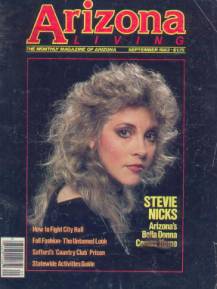
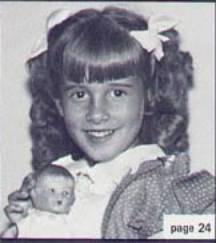
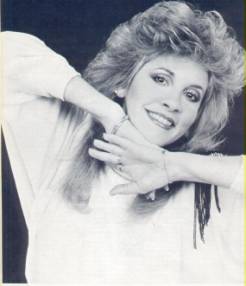
Innerview: Stevie Nicks
By Michael Lyons
Once upon a time, there lived a golden-haired princess named Stephanie. She grew up with dolls and toys and all the worldly things which make little girls happy. But Stephanie wanted more from life. In her mind, she saw crystal visions of a mystical world filled with gypsies, angels, good witches and white-winged doves. But try as she might, she couldn't fulfill her dreams.
Then one day, her fairy godfather, who lived in the enchanted world of Fleetwood, heard her melodic musings. He asked her to join him in a quest to discover musical adventures unknown. During their journey, they encountered enticing rumours and entangling chains. They saw silly penguins and mysterious tusks. Soon, everything Stephanie found turned to gold and she became the queen of rock & roll. Now, at last, she is contented.
PS--She expects to live happily ever after.
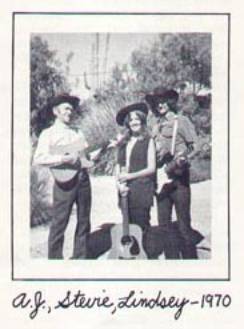 When Stephanie Lynn Nicks was born at Good Samaritan Hospital in Phoenix on May 26, 1948, rock & roll was only a gleam in Bill Haley's eye. It would be another eighteen years before Elvis Presley checked into Heartbreak Hotel and help create the kingdom which little "Stevie" would one day conquer. In some ways, her story is a dream-come-true fantasy. But her seemingly fairy-tale journey was also fraught with nightmarish interludes.
When Stephanie Lynn Nicks was born at Good Samaritan Hospital in Phoenix on May 26, 1948, rock & roll was only a gleam in Bill Haley's eye. It would be another eighteen years before Elvis Presley checked into Heartbreak Hotel and help create the kingdom which little "Stevie" would one day conquer. In some ways, her story is a dream-come-true fantasy. But her seemingly fairy-tale journey was also fraught with nightmarish interludes.
When Stevie was born, her father, Jess, was about to begin his own conquest--climbing the ladder in the corporate world. He eventually would become president of the Lucky Lager Brewing Co. of San Francisco, chairman and president of Armour & Co. as well as executive vice president of the Greyhound Corp.
Jess' ambitions steered the family through a non-stop meandering trek around the country. Though Stevie actually lived in Arizona for less than a year, she still calls it home.
"She always felt that she was an Arizonan," her father said. "We never really stayed in one place long enough for her to feel that she became a Californian, let's say, or a Utahan or a Texan. And I was born in Phoenix and her mother was born in Busbee, so her roots have always been tied closely to this state."
Another Arizona connection was Jess' father, A.J., a country & western musician who tried, but failed, to hit the big time. "When she was about four or five years old, her granddad made her a tiny little guitar," said Jess. "From that point forward, she shoed an aptitude and a desire to be involved in music. We gave her lessons, mainly on the guitar, and when she was old enough, we bought her a very good classical guitar. She was always extroverted. She loved to perform, loved to sing and loved to write songs."
Do you always trust
your first initial feeling?
--“Crystal”, 1973
When the family lived in San Francisco, Stevie met Lindsey Buckingham. "Lindsey was a senior in high school with my daughter and they joined the same band," Jess remembered. "Shortly thereafter, Lindsey's father died and we sort of took him in as a kind of stepson. He was at the house all the time."
Recalled Stevie, "When I first met him, he was going with somebody and so was I, but I fell totally in love with him. I was captivated."
Their friendship led to a partnership, both personally and professionally, after their band, Fritz, split up. Performing in California as a duo, they landed a deal with Polydor Records in 1973 to record an album.
Titled Buckingham Nicks, the record was a mix of lyrical ballads and mid-tempo rockers, all but one penned by Lindsey and Stevie. "Crystal" was a particular standout. Though Stevie wrote it, Lindsey sang it--a rare occurrence. "He truly does a better job on it," she said. "That song was a lot about my father and grandfather."
The album was dedicated to "A.J. Nicks, the grandfather of country music."
"I'm doing what he always wanted to do," said Stevie. "He was an eccentric show business person and didn't quite make it. He didn't have a vehicle to do this; he was married and had a family--what could he do? I think it was destroying him (not to be successful) because it's what he always wanted to do."
The album's cover was striking: a black-and-white waist-up photograph of the couple, nude, with shadows in appropriate places. The production was polished and the songs surprisingly strong for a first effort, but the album was not a success. It did garner sporadic radio airplay in some areas, however, including Phoenix. But Buckingham and Nicks were not yet stars.
Meanwhile, Stevie's parents were growing concerned. "She studed speech in college and we had really hoped that she would give up the music scene and become a teacher," said Jess. "We were supportive of her, though, all during her early days (as a performer) when things were difficult for her. We supported her, not only from an enthusiasm standpoint, but from a financial standpoint."
Though treading water, Stevie refused to give up. "I was really dedicated," she said, "and I thought I'd be a better music person. I think I would have been a very good teacher, too, but music was my life. Why should I quit to become a teacher? There are a million teachers; I wanted to be a rock & roller."
I've been afraid of changing
'cause I built my life around you
But time made you bolder
even children get older
And I'm getting older too
--"Landslide," 1974
In March 1974, Jess experiences chest pains and checked into the Mayo Clinic in Rochester, Minn. He had been taking up to 20 nitroglycerin tablets a day to combat angina, but tests showed the blood flow to his heart was severely constricted. Fearing he would not survive a flight back to Phoenix, doctors immediately operated to prevent a possible heart attack.
Six weeks later, Jess returned to work, but the pains also returned, so he retired. He was 49.
About this time, Stevie wrote "Landslide," Jess' favorite song by his daughter. "The words are meant to portray the relationship between a parent and child," he said, his voice breaking with emotion. "She wrote that song because she was fearful of my dying."
"I was also trying to make some decisions," Stevie said. "You know, "If you see my reflection in the snow-covered hills..." I was trying to figure out what I was going to do. I wasn't making it big in the music business. I was confused. He told me I should set a goal and give it about six months, and I kind of agreed with him... Though I might have quite working at the performing end of it, I always thought I'd make it as a songwriter. I would never have quit working toward that. Either I would make it or die trying."
All your life you've never seen
a woman (so) taken by the wind
--"Rhiannon," 1975
Stevie and Lindsey were finally "discovered" in a fashion which rivals the old Lana-Turner-in-a-drug-store story for its unlikeliness.
 Mick Fleetwood, leader of the veteran English band Fleetwood Mac, was in California scouting for a studio in which to record the band's next album. Fleetwood Mac started as a blues band nine years earlier, but after 10 albums and many personnel changes, "superstar" status continued to elude the group, though they were critics' favorites and perhaps the best-liked "second-on-the-bill" band around.
Mick Fleetwood, leader of the veteran English band Fleetwood Mac, was in California scouting for a studio in which to record the band's next album. Fleetwood Mac started as a blues band nine years earlier, but after 10 albums and many personnel changes, "superstar" status continued to elude the group, though they were critics' favorites and perhaps the best-liked "second-on-the-bill" band around.
During his search, Fleetwood listened to an album recorded at one studio under consideration. The album was Buckingham Nicks. He was impressed with the performance as well as the production. Forgetting the customary live audition, Fleetwood asked the duo to join the group. They readily accepted.
Ten days later, recording began for the album, which would be titled simply Fleetwood Mac. When it was released in July 1975, sales started slowly but steadily gained momentum. Early advertisements touting the new Mac line-up confused Stevie with Lindsey. (Stevie's gotta be the guy and Lindsey's the girl, right?) But their confusion soon dissipated. By the following summer, Fleetwood Mac had become the biggest-selling album to date for Warner Brothers Records.
It included three Buckingham compositions and three by Nicks--an updated version of "Crystal" (again sung by Lindsey), "Landslide" and the landmark "Rhiannon," a haunting tale of an 18th century Welsh witch. The latter became on of the album's three smash singles and introduced Stevie Nicks to most of the world.
In concert, the song became a showcase for the lithe fairy as she whirled around the stage in a flowing black chiffon dress, casting a spell over enraptured audiences. An image was born
Now here I go again
I see the crystal visions
I keep my visions to myself
--"Dreams," 1977
While the first album continued to sell, and as the group struggled to produce a worthy follow-up, Stevie and Lindsey separated. When Fritz broke up, the couple's personal relationship flourished. This time, the lovers split when the band flourished.
As awkward as the working situation was (the band's other couple, John and Christine McVie, had also separated), the interplay between musicians never sounded better.
The result: the awesome Rumours--an album whose impact must still send chills down the spines of industry executives. Released in February 1977, it was an instant smash, staying more than six months at the No. 1 spot on the national sales chart on its way to becoming the biggest-selling single-album in rock history. It spawned an unprecedented four Top 10 singles, including Stevie's mesmerizing chart-topper "Dreams." The album generally earned dazzling reviews: critics and record-buyers were in rare agreement.
Not included on the album was "Silver Springs," regarded by some as one of Stevie's most memorable compositions. Somehow, it was tucked away on the B-side of a single and didn't receive the exposure it deserved. A few years later though, Stevie's mother, Barbara, remembered the song when she named her Scottsdale antique shop The Silver Spring Emporium.
Rock on, gold dust woman
Take your silver spoon
and dig your gave
--"Gold Dust Woman," 1977
In the years that followed, the hits kept coming. Fleetwood Mac became rock's most popular act--the group even received a star on Hollywood's Walk of Fame. Stevie continued to cultivate her mystical, ethereal persona with songs like "Gypsy" and "Sisters of the Moon," and proved to be a sensitive songstress who could also rock out with the best.
In 1980, she produced her first solo album, Bella Donna. It was "once again," dedicated to my grandfather and all his children." It quickly became No. 1 and produced four hit singles. By then, she was hailed as "the queen of rock & roll."
To outsiders, such huge success provokes images of inflated egos and hedonistic excesses: wild parties, constant drugs; your basic Life in the Fast Lane. Were her parents worried?
"No, not really," said Jess. "Stevie was a very good child. I remember when she was a college sophomore--20 years old. She was going to a movie and her mother said, 'Now, Stevie, by golly, honey, it's a school night. You'd better be home my midnight.' The next day, Stevie told me, 'Daddy, I had to get up in the middle of the movie to be home in time, but I was here.' She was just a good child and we never felt that she'd do anything wrong...and she's always remained very stable."
Stevie said she doesn't remember the incident, "but if he said I did it, I'm sure I did because that was the law. They were very strict with me. They weren't nearly as strict with Christopher (her younger brother who now heads her official fan club)."
How has Stevie's success affected her parents? "Not one wit," Jess said. "We don't ever think about it much. We watch her success, of course, and stay very close to her...but we don't really think about her as anything other than our little girl."
Something in my heard died last night
It's one more chip off
an already broken heart.
--"Wild Heart," 1983
Stevie's second solo album, The Wild Heart, was released a few months ago. It is dedicated to Robin. "She was my best friend since I was 15," said Stevie, "and she was a definite guiding light in my life. She died of a horrible disease called leukemia. I still can't believe it. I still cry. I still get hysterical."
During her illness, Robin was helped by the City of Hope, a Los Angeles-based cancer institute. The charity is the beneficiary, along with the American Heart Association, of a fund-raising concert by Stevie Sept. 25 in Tempe (see opposite page).
Earlier this year, Stevie married Robin's husband, Kim, and became stepmother to a baby boy named Matthew. Is the rock & roll life-style compatible with motherhood?
"It's tough because I'm never home," Stevie answered, "but Matthew is a very special baby. He'll see this thing through and he'll be fine. Matthew is here for a definite reason. He has his own little path to follow from here."
"When Stevie passed 30 and had not gotten married," Jess revealed, "I honestly did not think she ever would. When a woman goes that long being single, and particularly when she's hugely successful, usually her career is so important that she won't get married. So at 34, when she did get married, it was quite a shock to her mother and me
"We met Kim a number of times when he was married to Robin. He's a very nice young man, but I can't say we were overly pleased with the marriage. Frankly, we felt that Stevie was possibly marrying Kim out of love for Robin and a feeling that somebody had to be a mother to a new baby. And we felt it was too early for her to marry Kim; Robin had been dead only four or five months. But she has tremendous intestinal fortitude and when she makes up her mind to do something, nobody can change it."
I'm not a child anymore
I'm tall enough to reach for the stars
--"Beautiful Child," 1979
Following the first six weeks of her nation-wide tour, Stevie Nicks returned to her California home for a couple of weeks' rest before resuming her concert schedule. Like many rock performers, she sleeps by day and works by night. Our conversation took place by phone on her "first real day off" in some time. She was exhausted and was catching a cold, but made certain to be awake to answer the phone at the appointed hour. Excerpts are below.
You're midway through your second solo tour. Is it easier this time around?
It's probably getting more difficult. The "Bella Donna" tour was something like 11 concerts--that was fun and it went by really fast. This one is really fun, but every night I've become more aware that I'm singing every song. I'm very used to having a lot of songs off [touring with Fleetwood Mac] so I can fix my makeup, comb my hair, wipe my face and just touch up a little bit. And now I can't. I'm in such a hurry that sometimes I run to the side of the stage and I'm not even sure what I'm running there for. So it's a lot more work, physically.
I'm doing exercises every day and I've lost a lot of weight. I'm really sort of in training, because in order to not run out of energy three songs before the set is over, I have to stay in really good shape. In the long run, of course, it's going to make me a much stronger person because it's forcing me to take good care of myself. Otherwise I could never get through that two-hour set.
Your new album and single are both in the Top 5--obviously record buyers like your new material. But some critics have not been as kind this time around. After so much success, do critics' barbs still bother you?
I don't even want to know about it. I don't even want to bring it into my life. There's no reason for it to hinder my creative state. Those people don't matter to me. Those aren't the people I write or sing for; I don't care if they live or die. I just ignore them completely.
What did you listen to when you were growing up?
The Ronettes--that kind of girl singing group. And the Supremes, Beach Boys, Spinners--a lot of R & B.
What do you listen to these days?
I'll have my favorites for a couple of weeks and then I'll change. Right now, I've been listening to some of my friend Joe Walsh's music--I've just come off the road with him. And I listen to Prince, and a couple of songs on the Flashdance album because that's what I do my exercises to. That's how I lost weight--dancing to "Maniac" 1,500 times a day.
What I do is make tapes of my favorite songs from different albums so I don't have to be changing back and forth. I sort of make my own K-Tel "you pick the hits" cassette.
Music videos are big right now. What do you think about them?
I don't like doing videos. It's not impulsive. It's doing something over and over and over again--and being told to do it over and over again...It focuses in on your performance--and also every little line on your face. I'm not a model; I don't sing because of the way I look. I sing because I love the music. I don't like my body being put under a microscope--that bothers me. Unfortunately, if you’re doing film, you have to do it. That's why I'll never be an actress.
Why did you sell your Scottsdale home?
Because I was never there. And you know what it's like to air condition a big house there. I kept it for a long time and when I went there it was wonderful. I wrote "Bella Donna," "Edge of Seventeen" and several of my most favorite songs in that living room. So it was very creative for me, going to Phoenix, but why have a beautiful home there when you have to be in Los Angeles all the time? And then I'd go home for one day and my parents would be kind of down if I didn't come to see them, so it just didn't work out very well.
What's your favorite Stevie Nicks song?
Overall it's hard to say because there have been a couple of favorites from different eras of my life. "Edge of Seventeen" definitely--that's probably the closest to being my favorite. It was written about my uncle Jon having cancer and that was about the time of [the murder of] John Lennon, and it was right before we knew Robin was sick--the final "white-winged dove." When it starts playing, my head turns around. "Sara" was my favorite--for that kind of song. Sara was, and is, the love of my life. There are different kinds of favorites. You have your miserable favorites and your happy favorites. I can't just pick one.
When you became so successful so fast, did you think you might become a rock & roll casualty?
No. If I were to become a rock & roll casualty, I would have become one right at the beginning, because that's when it's the hardest. You get pretty calloused after awhile traveling on the road. You just can't believe it.
Are you fairly certain, then, you'll be a survivor?
Oh, I'm absolutely certain. The people that overdose and the people that kill themselves purposely don't have anything else to do. I have my art, I have my writing, I have my book. I have to many other things to do besides sing and go on the road; that's only one part of my life. So now at 35 years old--or let's say 40, when I'll say, 'Oh I'm definitely too old to rock & roll because everyone else is 14--I won't have any reason to die.
The people who die become used to being famous. They're used to having a lot of money, they're used to traveling, they're used to the adulation. Then all of a sudden when it's over--and it's over for everybody eventually--it's like 'Now what?'
I'm not like that. I spend my spare time--when I should be sleeping--in my bathroom drawing or writing on the typewriter. I don't lack things to keep my creative juices going. In fact, I wish they'd dry up a little because then I'd get a little more sleep. As it is, I'm constantly obsessed with a new project. I'm already working on the next album; I'm about seven songs into it. So I have a reason to get up every day.
Rock & Roll Daddy
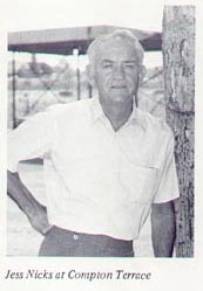 The mid-morning sun glared as Jess Nicks strolled across the grassy slopes of Compton Terrace, site of a benefit concert on Sept. 25 starring his daughter Stevie. He appeared content.
The mid-morning sun glared as Jess Nicks strolled across the grassy slopes of Compton Terrace, site of a benefit concert on Sept. 25 starring his daughter Stevie. He appeared content.
"The kids seem to like it here. They're free to move about and throw their frisbees," he explained, dodging an oncoming spray of water from a rotating sprinkler. "Oh, sometimes I leave them on all night," he interjected. "You don't lose as much to evaporation that way."
This green, peaceful, amphitheater, carved into the desert between Phoenix and Tempe, is now the center of activity for the 58-year old refugee from the stress-filled world of Big Business. Following heart surgery in 1974, Nicks--one of the men responsible for bringing the Greyhound Corp to Phoenix--traded the corporate boardroom for a small office, shared with his brother Gene, on the second floor of an Old West-style building adjacent to the Legend City amusement park. His agenda is now occupied by big name rock & roll performers.
In his post-corporate life, Nicks has become active in the Arizona chapter of the American Heart Association, serving as a director and at one point, as chairman of the board. He has also organized special events for the group, including an annual charity gold tournament, held at Camelback Country Club for the past five years. And with a little help from his daughter and her friends, he became an occasional concert promoter, booking Fleetwood Mac into the Phoenix Civil Plaza for a 1975 fund-raiser, and two years later for an encore at the University of Arizona. The Tuscon show, which raised $260,000 for the Heart Association, drew the largest crowd ever to see a rock concert in Arizona--until the Stones rolled through Tempe two years ago.
Pleased with his success and becoming increasingly bored with early retirement, Nicks co-founded Compton Terrace in 1979. Its debut program was also a Heart Association fund-raiser--this time starring Arizona favorites Jerry Riopelle and John Stewart. Both performers were local stars, primarily because of the late William Edward Compton, legendary program directory at KDKB radio from 1971-1976. During his influential tenure on the Valley's airwaves, Compton also introduced his listeners to then then-unknown duo of Stevie Nicks and Lindsey Buckingham.
Compton died in a 1977 car crash, but his name lives on--at the concert facility in Arizona and beyond the state in Jess Nicks' company, Compton Terrace Concerts. Outside Arizona, Nicks has promoted acts like the Eagles and Boz Scaggs, as well as producing or co-producing every stop of this year's tour for his daughter.
This month's "Stevie Nicks and Friends" show at Compton Terrace is a fund-raiser for the American Heart Association and the City of Hope. It will also star Kenny Loggins, veteran of the 1977 Tuscon fund-raiser and vocal partner with Stevie on the 1978 hit "Whenever I Call You Friend." Also featured will be Joe Walsh, known for his work with the James Gang ("Walk Away"), as a mid-season replacement with the Eagles ("Life in the Fast Lane") and as a solo artist ("Rocky Mountain Way," "Life's Been Good").
Unlike last April's Frank Sinatra "benefit" concert in Phoenix--in which Ol' Blue Eyes was paid a quarter of a million dollars to perform at a charity fund-raiser--Stevie, Loggins and Walsh will work gratis. "There shouldn't be any expenses for us except transportation costs for the bands to come here and then go back to wherever they came from. That's it. They will not be paid one single dime. And, all of our staff at Compton--our security people, our catering people, our production people--all are going to donate their time, so it will be a true benefit," said Nicks.
The concert will (be) among the last the exisiting Compton Terrace. Salt River Project, whose headquarters are adjacent to the facility, recently bought the entire Legend City complex. (Nicks leases the property from the amusement park's owners.) This season's concerts will end in November, but Nicks is firmly committed to relocating in the area. He plans to retain the Compton Terrace name.
In a 1973 hit, Loggins complained, "Your mama don't dance and your daddy don't rock & roll." But this daddy does rock & roll. Though his tastes are rooted in country music, Nicks has adapted.
"When we first started Compton Terrace, I'd go out during every show and listen to the bands for 30 minutes or so," he recalled. "In the beginning I couldn't even understand the words. Unless you're a young person who has grown up with the rock scene, you have to more or less become educated in the rock music world. But now, over the four-and-a-half years we've been here, I've gotten to where I understand what they're trying to do, and I've developed an appreciation for it."
--ML
Thanks to Jennifer Gibson for typing the article and sending it to the Nicks Fix. See the article on Jennifer's site.
| The Nicks Fix main page |